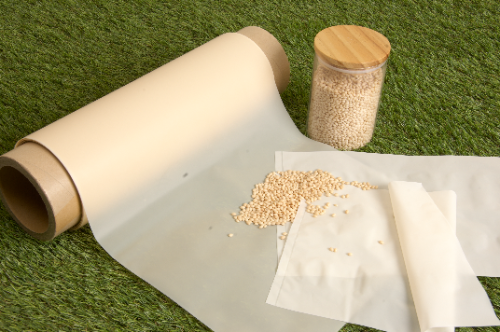Anticipated to expand at a Compound Annual Growth Rate (CAGR) of 5.6%, the global biodegradable films market is poised for substantial growth. Projections indicate a significant uptick in market value, soaring from US$ 1,040.1 million in 2022 to an impressive US$ 1.7 billion by 2032. In 2021, the market already showed promise with a valuation of US$ 1,000.5 million, with expectations of a Year-on-Year (Y-o-Y) growth rate of 5.4% in 2022. Such robust growth underscores the increasing demand for eco-friendly packaging solutions across various industries, driving innovation and adoption of biodegradable films on a global scale.
The surge in demand for biodegradable films is unmistakable across sectors such as food, agriculture, and cosmetics, especially notable in the food industry, packaging, and distribution realms. Industries focused on food packaging and distribution are increasingly drawn to the exploration and incorporation of bioplastics for their applications in food-related contexts, attracting significant attention. Biodegradable films offer a wide array of uses within the food sector, spanning from edible coatings to paper boards, egg trays, carry bags, wrapping films, and various forms of food packaging. This shift reflects a broader industry movement towards sustainability, with a concerted effort to minimize environmental impact.
The Indian market is on the brink of experiencing a significant surge in demand for biodegradable films, primarily fueled by the absence of robust packaging collection and recycling infrastructure for waste management. Heightened pressure on fast-moving consumer goods (FMCG) manufacturers, retailers, and regulatory bodies to address packaging waste has reached new heights. Additionally, there is a distinct willingness among Indian consumers to invest in environmentally sustainable food packaging, even at a premium compared to their counterparts in other nations. This signals a notable shift towards eco-consciousness and a preference for green packaging solutions, in line with the escalating focus on eco-friendly practices and efficient waste management practices in the country.
Request Sample Report Here: https://www.futuremarketinsights.com/reports/sample/rep-gb-11372
Market Drivers:
- Environmental Concerns: Increasing awareness about environmental issues, particularly plastic pollution, has driven the demand for biodegradable films as an eco-friendly alternative to traditional plastics.
- Government Regulations: Stringent regulations and policies imposed by governments worldwide to reduce plastic waste and promote sustainable practices have propelled the adoption of biodegradable films.
- Consumer Preference: Growing consumer preference for sustainable and eco-friendly packaging solutions has led to a surge in demand for biodegradable films across various end-user industries such as food packaging, agriculture, and pharmaceuticals.
- Technological Advancements: Ongoing research and development efforts have led to technological advancements in biodegradable film production, resulting in improved performance characteristics and cost-effectiveness, further driving market growth.
- Shift in Manufacturing Practices: Many companies are shifting towards sustainable manufacturing practices to align with corporate social responsibility (CSR) goals and cater to the increasing demand for environmentally friendly products, thus boosting the biodegradable films market.
- Market Expansion: Expansion of end-user industries such as food and beverage, agriculture, and cosmetics, coupled with increasing consumer awareness, is expected to drive the demand for biodegradable films.
Market Restraints:
- Cost Constraints: Biodegradable films often have higher production costs compared to conventional plastic films due to the use of biodegradable materials and specialized manufacturing processes, which may hinder their widespread adoption, particularly in cost-sensitive markets.
- Limited Performance: Some biodegradable films may have limitations in terms of mechanical strength, barrier properties, and shelf life compared to traditional plastics, restricting their applications in certain industries and products.
- Infrastructure Challenges: Inadequate waste management infrastructure for composting and recycling biodegradable films in many regions poses a significant challenge, limiting the effectiveness of these films in achieving their environmental benefits.
- Certification and Standards: Lack of standardized testing methods and certifications for biodegradable films can lead to confusion among consumers and businesses regarding the performance and environmental claims of different products, hampering market growth.
- Competitive Landscape: The biodegradable films market faces competition from conventional plastics as well as other sustainable packaging alternatives such as recyclable plastics, compostable plastics, and paper-based packaging materials, which may impact market penetration and growth.
- Supply Chain Challenges: Ensuring a consistent and reliable supply of raw materials for biodegradable film production can be challenging, especially for bio-based materials sourced from agricultural feedstocks, leading to supply chain disruptions and price volatility.
Key Players
Some of the key players operating in the global biodegradable films market are as follows:
- Taghleef Industries Group
- Cortec Corporation
- Clondalkin Group
- Futamura Group
- Storopack, Inc.
- Transilwrap Co., Inc.
- Accredo Packaging, Inc.
- POLYNOVA Industries Inc.
- Tipa Corporation
- Plastiroll Oy Ltd.
Competitive Landscape-
- In October 2021, Walki Group acquired the French packaging producer Rollpack to expand its geographical footprint.
- In December 2020, BASF and BillerudKorsnäs cooperated to develop unique home-compostable paper laminate for flexible packaging.
Request Customization:
https://www.futuremarketinsights.com/customization-available/rep-gb-11372
Key Segmentations
The global biodegradable films market has been segmented into material, application, thickness, and end-user industry.
On the basis of material
- Bio-LDPE (Low Density Polyethylene)
- Bio-MDPE (Low Density Polyethylene)
- Bio-HDPE (Low Density Polyethylene)
- Bio-based PLA (Polylactic Acid)
- Others
On the basis of application
- Bags
- Mulch Films
- Wrapping Films
- Liners
- Others (Sheets, etc.)
On the basis of thickness
- Up to 1 mil
- 1-3 mil
- Above 3 mil
On the basis of end-user industry
- Food & Beverages
- Healthcare
- Personal Care & Cosmetics
- Agriculture
- Waste Management
- Others
On the basis of Region
- North America
- Latin America
- Europe
- Middle east and Africa
- East Asia
- South Asia
- Oceania
About Future Market Insights (FMI)
Future Market Insights, Inc. (ESOMAR certified, recipient of the Stevie Award, and a member of the Greater New York Chamber of Commerce) offers profound insights into the driving factors that are boosting demand in the market. FMI stands as the leading global provider of market intelligence, advisory services, consulting, and events for the Packaging, Food and Beverage, Consumer, Technology, Healthcare, Industrial, and Chemicals markets. With a vast team of over 5000 analysts worldwide, FMI provides global, regional, and local expertise on diverse domains and industry trends across more than 110 countries.
Contact Us:
Future Market Insights Inc.
Christiana Corporate, 200 Continental Drive,
Suite 401, Newark, Delaware – 19713, USA
T: +1-845-579-5705
For Sales Enquiries: sales@futuremarketinsights.com
Website: https://www.futuremarketinsights.com
LinkedIn| Twitter| Blogs | YouTube


